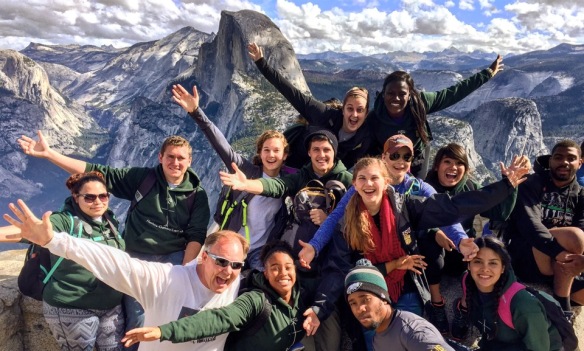 The United States’ national parks are known as “America’s greatest university without walls,” yet the Interior Department reports that the number of college-age visitors fell from 27% to 19% (Blaszak, 2006). Interest from college students normally sparks when they visit the parks as a child, but the annual number of visitors under the age of 15 has fallen by half in recent years (Bergeron, 2015). Two scientific studies show why educators need to get their students out to America’s most beautiful places.
The United States’ national parks are known as “America’s greatest university without walls,” yet the Interior Department reports that the number of college-age visitors fell from 27% to 19% (Blaszak, 2006). Interest from college students normally sparks when they visit the parks as a child, but the annual number of visitors under the age of 15 has fallen by half in recent years (Bergeron, 2015). Two scientific studies show why educators need to get their students out to America’s most beautiful places.
John Muir, known as the “Father of our National Parks”, earned a living growing and selling fruit in the San Francisco Bay Area. Like many people, he battled with all the stresses and fatigues of work and life, but Muir found the mountains and forest to be the best cure for the daily grind. As he collected his thoughts near the end of his life, in 1912, Muir wrote , “everybody needs beauty as well as bread, places to play in and pray in, where nature may heal and give strength to body and soul alike“ (Muir, 1912). Researchers now find evidence that backs Muir’s idea that going to the mountains can do amazing things like boosting your immune system, lowering your blood pressure, and accelerating recovery time from surgery or illness (Li, 2010). It turns out that the trees give off an active substance called phytoncides that prevents the tree from rotting or being eaten by insects. Just three days exposure to these plant compounds prove to boost the tumor and virus-killing cells in our bodies, and the effect lasts for up to 30 days (Li, 2010).
As a Dean of Students, I experienced first-hand the rise of mental illness on our college campuses. Suicide rates rose 200 percent and one-third of college students today report that they felt so depressed that it was difficult to function (Henriques, 2015). Science proves that time spent outdoors and in our forests reduces stress and improves mood, energy level, and sleep. Studies also show that students with ADHD can improve attention fatigue just by being in nature. I have witnessed first-hand how my students who battle with ADHD and depression come back refreshed and renewed after being in the national parks.
A series of recent university studies found that those who experience awe of the natural world are kinder and more ethical (Piff, 2015). Part of the study put them in a grove of towering trees and observed how they became better helpers and less entitled compared to control groups. The study shows those who experience awe turn out to also be the most generous. People have a better compassion for all around them when they understand how they are just a small part of larger eco-system. I think we all would enjoy living in this type of kinder and more generous world, and our national parks represent the best place I know to find this sense of awe and wonder.
An old Chinese proverb explains the best time to plant a tree was 20 years ago and the second-best time is now. Just like the growth of trees, I find learning happens slowly over a lifetime and savored best when revisited time and time again. If you are feeling weary or uninspired, follow Muir’s call for renewal by bathing yourself in nature. Travel is better with friends and family, and I hope you can use our national parks as a natural classroom to teach and pass down our nation’s history, culture, and appreciation for beauty. Discover our heritage as well as human traits like awe, generosity, and kindness inside America’s greatest university without walls.
Brian Dawson, M.S. History
Doctoral Student, Doctorate in Leadership, Hardin-Simmons University
CEO, Semester by the Sea
BrianD@Calamigos.com
See more on this at my Ted Talk at: https://youtu.be/kF-Y3qiiOQU
References
Bergeron, R., & Redlitz, S. (2015, March 20). Does National Park Service have a youth problem? Retrieved May 3, 2018, from https://www.cnn.com/2015/03/19/us/im-national-parks-older-visitors-morgan-spurlock/index.html
Blaszak, M. (2006, April 6). National Park System Visitation Trends. Retrieved May 3, 2018, from https://www.doi.gov/ocl/nps-visitation-trends
Henriques, G. (2015, February 15). The College Student Mental Health Crisis. Retrieved May 3, 2018, from https://www.psychologytoday.com/us/blog/theory-knowledge/201402/the-college-student-mental-health-crisis
Li, Q. (2010). Effect of forest bathing trips on human immune function. Environmental Health and Preventive Medicine, 15(1), 9–17, from http://doi.org/10.1007/s12199-008-0068-3
Muir, J. (1912). The Yosemite. New York, NY: The Century Company.
Piff, P. K., Dietze, P., Feinberg, M., Stancato, D. M., & Keltner, D. (2015). Awe, the small self, and prosocial behavior. Journal of Personality and Social Psychology, 108(6), 883-899.

